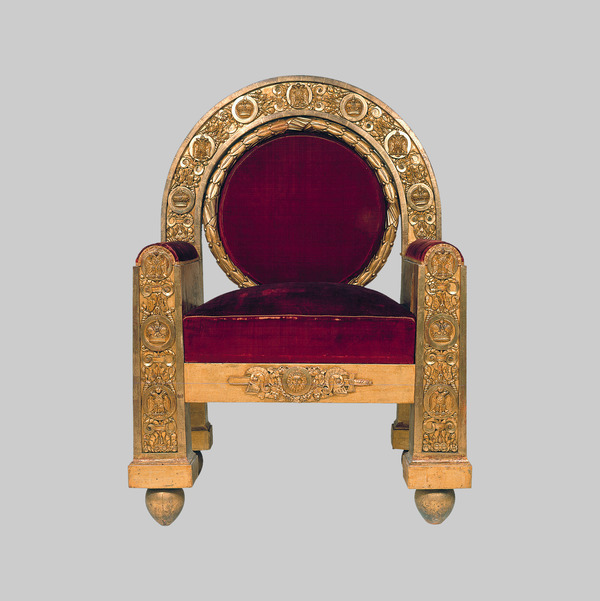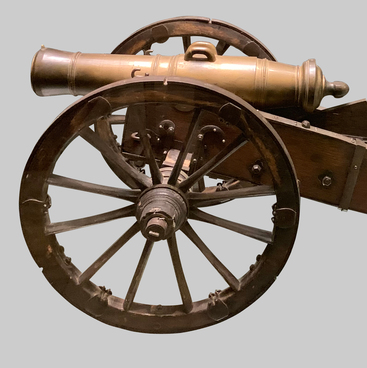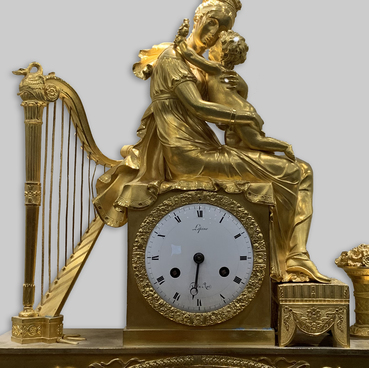The Throne Chair is a remarkable example of ceremonial ‘palatial’ Empire style so much loved by the Russian and French nobility. The heavy gilded chair with clear geometric forms and proportions is done in the ‘ancient Roman’ style, the way it was imagined in the 19th century, obviously.
The round insert in the back is encircled in a carved gilded garland of laurel leaves, a sign of imperial power, and a symbol of victorious emperors. Other attributes – coats of arms, crowns, royal-colour upholstery, etc. – also indicate imperial designation of the chair.
Experts believe that this outstanding example of furniture was commissioned by the Moscow authorities for Alexander I. The gift was supposed to be presented to the ruler during his visit to the capital in 1817 on the occasion of festivities to mark the fifth anniversary of deliverance from the Napoleonic invaders. The throne was meant to be a symbolic reminder of Russia’s great victory and revival of its old capital city which had been nearly totally destroyed.
Ironically, furniture masters drew their inspiration from the throne chairs of Napoleon Bonaparte himself made in 1804 to the sketches of interior decorators Charles Percier and Pierre Fontaine. Emperor Alexander was in correspondence with the French decorators and in 1809 he even got from France sketches of buildings and monuments of the time of Bonaparte’s empire specially done by them for him. And when in 1814, the allies’ boots stepped on the Parisian cobble stones, Fontaine, once again requested by the Russian emperor, had decorated La Place de la Concorde for a ceremonial public prayer on Resurrection of Christ Day.
But let us go back to the throne. Some of the artistic techniques used to create it suggest that architect Auguste de Montferrand could have had a hand in it. There was a time when he studied the specificities of the Empire style at Percier and Fontaine’s studio, and then in 1816, he offered his talents to the service of Russia.
It could have been none other than Montferrand that used Napoleon’s throne as an example for a throne chair for the Russian emperor. The purpose of doing it must have been to once again symbolically emphasise not only the idea of power but also the idea of the Russian emperor’s victory over the French emperor won in the great war of 1812.
The round insert in the back is encircled in a carved gilded garland of laurel leaves, a sign of imperial power, and a symbol of victorious emperors. Other attributes – coats of arms, crowns, royal-colour upholstery, etc. – also indicate imperial designation of the chair.
Experts believe that this outstanding example of furniture was commissioned by the Moscow authorities for Alexander I. The gift was supposed to be presented to the ruler during his visit to the capital in 1817 on the occasion of festivities to mark the fifth anniversary of deliverance from the Napoleonic invaders. The throne was meant to be a symbolic reminder of Russia’s great victory and revival of its old capital city which had been nearly totally destroyed.
Ironically, furniture masters drew their inspiration from the throne chairs of Napoleon Bonaparte himself made in 1804 to the sketches of interior decorators Charles Percier and Pierre Fontaine. Emperor Alexander was in correspondence with the French decorators and in 1809 he even got from France sketches of buildings and monuments of the time of Bonaparte’s empire specially done by them for him. And when in 1814, the allies’ boots stepped on the Parisian cobble stones, Fontaine, once again requested by the Russian emperor, had decorated La Place de la Concorde for a ceremonial public prayer on Resurrection of Christ Day.
But let us go back to the throne. Some of the artistic techniques used to create it suggest that architect Auguste de Montferrand could have had a hand in it. There was a time when he studied the specificities of the Empire style at Percier and Fontaine’s studio, and then in 1816, he offered his talents to the service of Russia.
It could have been none other than Montferrand that used Napoleon’s throne as an example for a throne chair for the Russian emperor. The purpose of doing it must have been to once again symbolically emphasise not only the idea of power but also the idea of the Russian emperor’s victory over the French emperor won in the great war of 1812.



